Operation Suvorov. How the Red Army liberated Smolensk
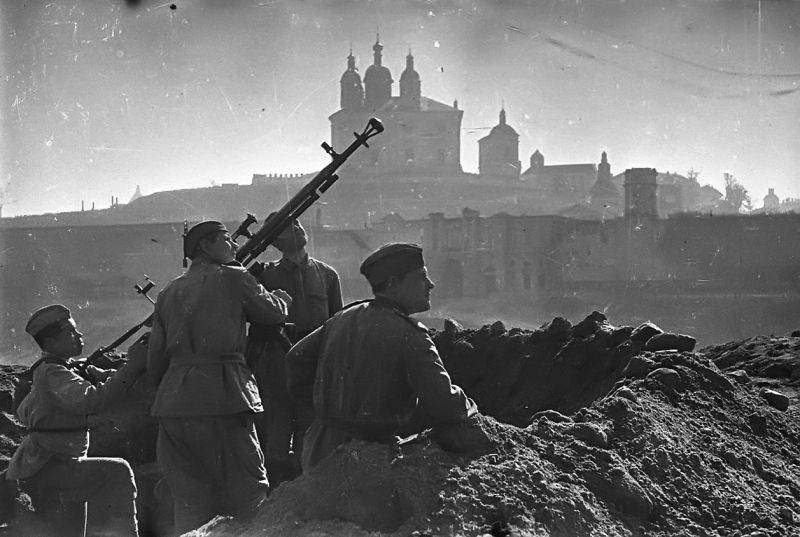
Anti-aircraft crew of Sergeant Major Ivan Mikhalev in liberated Smolensk, armed with a large-caliber (12,7 mm) DShK machine gun. Cathedral Hill and the Assumption Cathedral are visible in the background. September 25, 1943
Occupation of Smolensk
The Smolensk region was among the first to take the blow of Nazi troops. Already in June 1941, the German mobile forces of Army Group Center broke through to the Western Dvina in the Vitebsk region and the Dnieper near Orsha and Mogilev. On July 10, 1941, the defensive Battle of Smolensk began. On July 16, Guderian's units invaded the city. Fighting raged in the outskirts and on the streets of the city for more than two weeks. On July 19, the Germans penetrated into Yelnya, and troops of the 16th, 19th and 20th Soviet armies were surrounded.
On July 21, the Red Army launched a counteroffensive, trying to remove the remnants of the blocked armies from the cauldron. However, the Germans continued their offensive, and on the night of July 29, our troops finally abandoned Smolensk. On August 1–21, the Red Army and the Wehrmacht fought on the Smolensk Bulge. The Germans captured Roslavl, our troops unsuccessfully counterattacked. On August 16, Soviet troops again counterattacked with the aim of defeating the enemy’s Yelninsky group. August 22 – September 10, the Soviet Western Front made a new attempt to return the line of Velizh, Demidov and Smolensk, the troops of the Reserve Front made their way to Yelnya. On September 6, our troops recaptured Yelnya, but were unable to advance further.
The Smolensk defensive battle was difficult and bloody: Soviet troops lost more than 700 thousand people killed and wounded. However, the Wehrmacht's breakthrough to Moscow was delayed, which became one of the prerequisites for the failure of the blitzkrieg. The Soviet Guard was born in fierce battles in the Smolensk region.
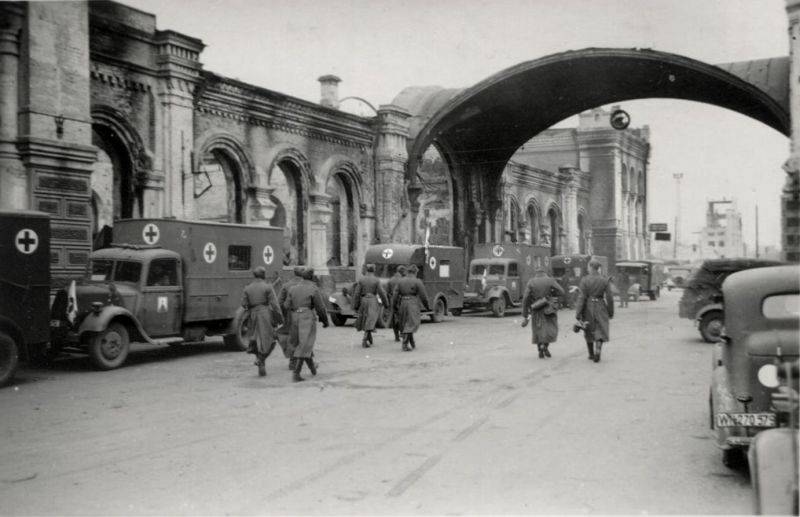
German soldiers pass under an arch at the train station in occupied Smolensk. An iron arch divided the station buildings according to the directions of travel - the Moscow-Brest (on the left) and the Rigo-Orlovskaya railways. All station buildings were completely destroyed by the Nazis
The occupation of Smolensk lasted more than two years. The Smolensk district was part of the General Commissariat "Ostland" - together with Belarus and the Baltic states. Hitler's occupation was difficult for the Smolensk region. The population, which was about 1939 million people in 2, was almost halved by the end of the war. In total, during the period of occupation of the region, the Nazis killed more than 150 thousand civilian Soviet citizens, drove more than 160 thousand to work in the Third Reich, and killed 230 thousand prisoners of war.
These are the data of the State Emergency Commission of 1945. The Nazis burned about 5 thousand Smolensk villages. About 300 villages were burned along with their inhabitants - the Nazis took revenge for supporting the partisans. So, in March 1943, the Germans rounded up about 400 residents of neighboring villages into the village of Chertovka and burned them.
Of the 170 thousand residents of Smolensk, by the time the city was liberated in September 1943, 20 thousand remained alive. 35 thousand civilians and more than 100 thousand prisoners of war were killed in the city, about 90 thousand people were driven into slavery. The city itself was almost completely destroyed. The title of Hero City was awarded to Smolensk in 1985.
The Nazi policy aimed at destroying “Soviet subhumans” caused powerful popular resistance. Despite all the punishments and mass bloody terror, by the spring of 1942 the partisans liberated 25 of the 42 occupied regions from the Nazis. They became “partisan regions.” The partisans, through their actions, pinned down the enemy army and supported the offensive of the Red Army in 1943.
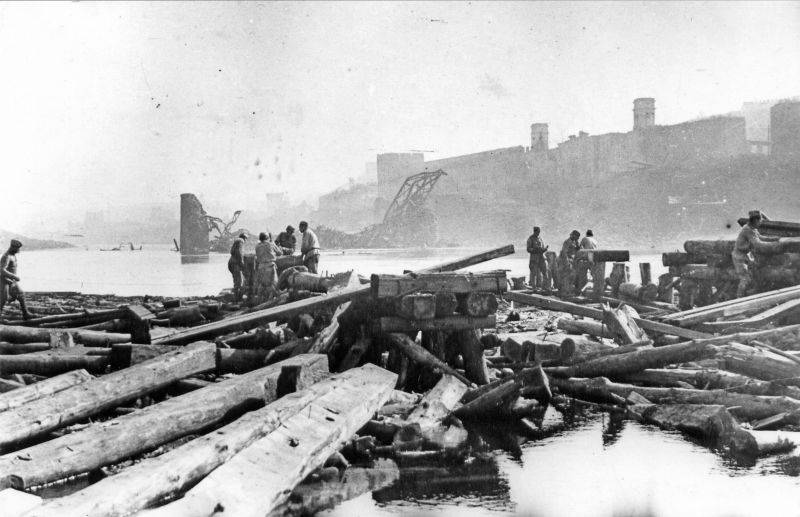
Soviet sappers restore the destroyed bridge across the Dnieper in liberated Smolensk
General situation
The Soviet Headquarters for the summer - autumn of 1943 planned, after repelling the enemy offensive, to launch a large-scale offensive in a wide strip from the Sea of Azov to Smolensk in order to liberate Left Bank Ukraine, cross the Dnieper, and enter the territory of Right Bank Ukraine and Belarus.
Great importance was attached to the defeat of the “Center” group, which, holding the line west of Kirov, Spas-Demensk, Yartsev and Velizh, was located 250-300 km from Moscow. That is, the Germans maintained a bridgehead aimed at the Soviet capital. The Kalinin and Western fronts were supposed to reach the line of Smolensk and Roslavl.
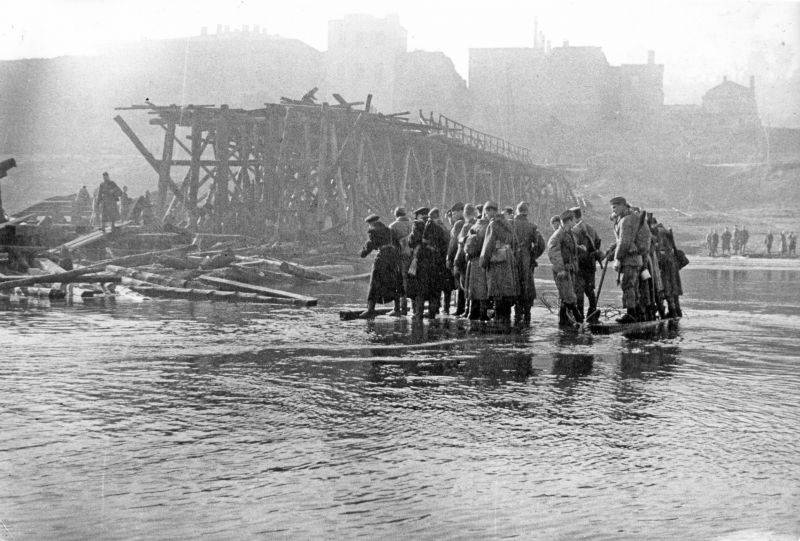
Soviet infantrymen cross the Dnieper in liberated Smolensk
The main blow was delivered by the Western Front (WF) under the command of General Sokolovsky. The Polar Front was supposed to defeat the enemy in the areas of Yelnya and Spas-Demensk, and then develop the offensive towards Roslavl. At the same time, part of the forces of the right wing of the Polar Front, in cooperation with Eremenko’s Kalinin Front (KF), advanced on Yartsevo and Dorogobuzh, aiming at Smolensk.
Stalin attached great importance to Operation Suvorov, and at the beginning of August 1943, for the first time in the entire war, he personally visited the command posts of the Western and Kalinin fronts, hearing reports there from Sokolovsky and Eremenko.
The German command understood that the collapse of defense in the central strategic direction was very dangerous. The Germans expected major operations by the Red Army in this direction. The Germans concentrated their efforts on the stubborn defense of the occupied territories. In the Smolensk and Roslavl directions, five or six defensive stripes and lines were prepared, echeloned by 100–130 km.
The rear lines usually ran along the banks of rivers. They dealt with the troops as needed. The cities of Novosokolniki, Vitebsk, Surazh, Rudnya, Dukhovshchina, Yartsevo, Dorogobuzh, Yelnya, Spas-Demensk, Demidov, Smolensk, Roslavl were turned into powerful centers of resistance, prepared for all-round defense. Roads in key directions were mined.
In a strip 600 km wide, the command of Army Group Center under Field Marshal Kluge had 44 divisions of the 3rd tank, 4th and partly 2nd Panzer Armies of Reinhardt, Heinrici and Model. This group consisted of 850 thousand soldiers and officers, 8 guns and mortars, about 800 tanks and assault guns, and up to 500 combat aircraft.

Operation Suvorov
At the beginning of the operation, the CF included the 3rd and 4th shock troops, the 43rd, 39th and 3rd air armies, the 3rd Guards Cavalry Corps, and the Polar Fleet included the 31st, 5th, 10th -I Guards, 33rd, 49th, 10th, 50th, 68th, 21st and 1st Air Armies, 5th Mechanized and 6th Guards Cavalry Corps. In total, more than 1,2 million people, over 20 thousand guns and mortars, more than 1,4 thousand tanks and self-propelled guns, 1 combat aircraft. However, the divisions were understaffed - the average number of rifle divisions was 100–6,5 thousand people. The troops experienced a shortage of ammunition (7–2 rounds of ammunition) and fuel (2,5–1,3 rounds of ammunition).
The commander of the Polar Fleet, Sokolovsky, in the direction of the main attack, allocated the 10th Guards, 3rd, 68th and 21st Armies, the 5th Mechanized and 6th Guards Cavalry Corps. Soviet troops had to break through enemy defenses in a 16 km wide area, defeat the main forces of the German 4th Army, liberate the important communications hub of Roslavl, then reach the Yartsevo, Pochinok, Dubrovka line. The planned depth of advance was 180–200 km. On the right wing of the front, the forces of the 31st and 5th armies launched strikes with the aim of defeating the enemy in the areas of Yartsev and Dorogobuzh, followed by the development of an offensive in cooperation with the CF troops towards Smolensk. The 10th Army advanced from the Kirov area to Obolovka and Vorontsovo.
The commander of the KF troops, Eremenko, delivered the main blow with the forces of the 39th Army from the Dmitrovka area in the direction of Dukhovshchina, Smolensk. Zygin's army was supposed to defeat the German 27th Corps and, together with the troops of the right wing of the Polar Front, liberate Smolensk. The second blow was delivered by Golubev’s 43rd Army from the area northeast of Verdino in the general direction of Skugrevo (15 km southeast of Demidov).
The bulk of the artillery was concentrated in strike groups. In the Polar Fleet, 4 guns and mortars were involved in the artillery preparation of the attack, and in the KF - 950. The artillery density in the 1th Army reached 653, and in the 39th Guards and 130rd Armies - 10 units per 33 km.
The Soviet command planned to defeat the left wing of the German Army Group Center and prevent the transfer of its divisions to the south, where the Red Army was delivering the main blow. Finally remove the threat of the Wehrmacht attack on Moscow, liberate the Smolensk region and part of Belarus.
The operation received the code name "Suvorov".

It was not possible to break through the Wehrmacht defenses on the move
German intelligence discovered Russian preparations for an offensive in the Smolensk direction. Therefore, the attack was not sudden. The German command strengthened its battle formations.
On August 7, 1943, after strong artillery preparation, the divisions of the 10th Guards and 33rd armies of Trubnikov and Gordov went on the offensive. The fighting immediately became protracted. The Nazis fiercely resisted and counterattacked. By the end of the day, our troops had penetrated 4 km into the enemy’s defenses. On August 8, the command of the Polar Fleet brings the second echelon into battle, but without much success. The Germans also managed to transfer reinforcements from the Oryol direction - parts of the 2nd Tank, 36th and 56th Infantry Divisions. The Soviet command throws into battle a mobile formation that had to be introduced into the already breached hole, Sokolov’s 6th Guards Cavalry Corps. However, the guards met strong enemy resistance at the intermediate line, and a breakthrough in depth was not possible.
On August 9, Chief Marshal of Artillery Voronov, as a representative of the Headquarters on both fronts, reported to Stalin that the enemy was well prepared for defense and knew about the impending offensive. Some of our divisions are not ready for offensive operations; there are not enough breakthrough tanks. Rifle unit commanders do not know how to interact with our strong artillery.
Marshall also noted:
Voronov asked Headquarters to allocate more ammunition, tanks, artillery and join in the operation Aviation long range.
Over seven days of intense fighting, the Polar Front troops, at the cost of heavy losses, penetrated the enemy’s defenses 12–16 km, breaking through the tactical defense zone in a strip 25–30 km wide.
On the right wing of the front, the troops of the 31st and 5th armies of Gluzdovsky and Polenov advanced only 7–8 km during August 3–5. Only Popov's 10th Army, which went on the offensive on August 10, was able to make a hole in the enemy defenses up to 10 km wide and deep in two days. Sokolovsky decided to transfer Volkov’s 5th mechanized corps to this area, where there was success. Having completed a 130-kilometer march, he concentrated in a new area by the end of August 12.
On the morning of August 13, the tankers went on the offensive, but the enemy also did not sleep and had already managed to prepare defenses at the intermediate line. Instead of a breakthrough, the mechanized corps was drawn into protracted battles in the Tyagaev area. On August 14–16, Soviet divisions penetrated the enemy’s defenses another 5–10 km. The mechanized corps, having lost its striking power, was withdrawn to the rear.
Although ours were unable to break into the defenses, there was a threat of the Russians reaching the rear of the German group in the Spas-Demensk area. The German command begins to withdraw troops. Grishin's 49th Army begins pursuit and on August 13, with the support of the 33rd Army, liberates Spas-Demensk.

Soviet infantry on the approaches to Spas-Demensk. August 1943
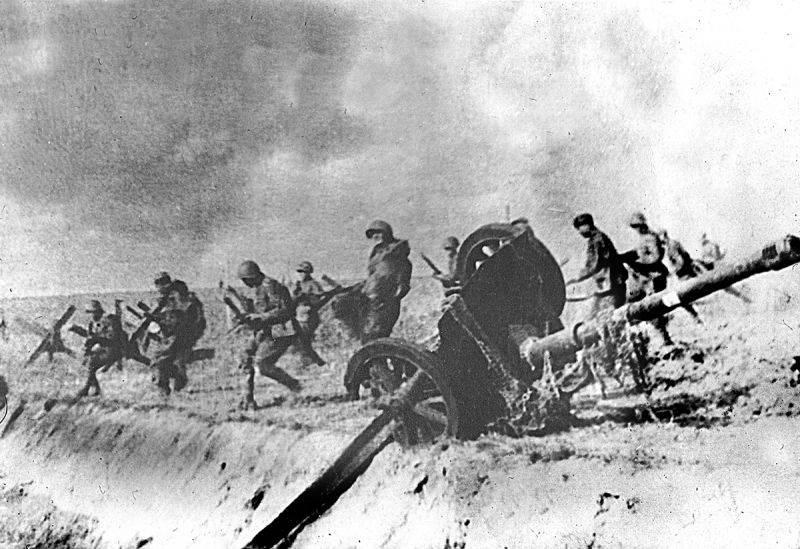
Red Army soldiers run to the anti-tank ditch past a broken German 75-mm PaK 41 anti-tank gun during the assault on the Gnezdilovsky Heights (height 233,3, 3 km from the village of Gnezdilovo, Spas-Demensky district). The photo was taken during the offensive operation of the Western Front troops during the Spas-Demen operation. August 1943
On August 13, Zygin's 39th Army went on the offensive. In six days of fighting, she pushed the Germans back by 5–6 km. The Germans actively counterattacked; during the first day alone, enemy infantry, supported by tanks and aircraft, launched counterattacks 24 times.
Thus, at the first stage, it was not possible to break into the Wehrmacht’s defenses and introduce mobile formations into the gaps. The Germans, relying on strong defenses, fought skillfully and transferred the necessary reinforcements. From August 1 to August 18, the German command transferred up to 13 divisions, significantly increasing the combat potential of the 4th Field Army. Soviet troops bit into the enemy's defenses and pushed him back. It was possible to make noticeable progress only in the Spas-Demen direction, since here the Germans themselves retreated. There was a noticeable shortage of ammunition.
The offensive in the Smolensk direction distracted German forces from the south. On August 28, Kluge reported to the Fuhrer that there could be no question of withdrawing forces from his sector of the front to help Army Group South.
On August 25, Deputy Chief of the General Staff General Antonov reported to Stalin on the progress of the operation:

Soviet soldiers remove a German sign in the liberated Spas-Demensk
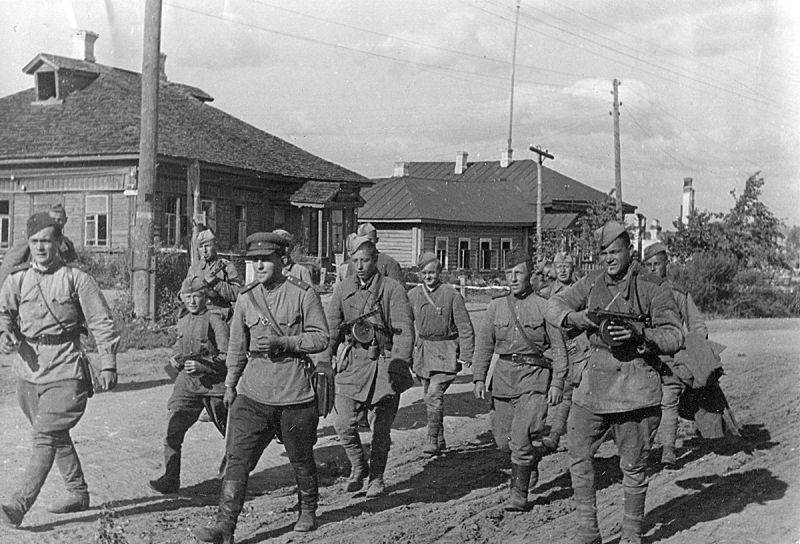
Soldiers and commanders of the Red Army on the street of liberated Spas-Demensk
To Yelnya
By the beginning of the third decade of August 1943, the general situation on the Soviet-German front had changed significantly.
The Soviet armies successfully developed an offensive in the southern direction. Troops of the Bryansk and Central Fronts reached the approaches to Lyudinov and Bryansk, threatening the southern flank of the Center group. Further advance of the armies of the right wing of the Bryansk Front made it possible to cover the Roslavl Wehrmacht group from the southern flank.
The command of the Polar Fleet decides to change the direction of the main attack from Roslavl to Yelnya and Smolensk. The main blow is delivered by the 10th Guards, 21st and 33rd armies. Subordinate to Krylov’s 21st Army was the 2nd Guards Tank Corps and seven artillery brigades, which arrived from the Supreme Command Headquarters reserve, and the 33rd Army was subordinate to the 5th Mechanized and 6th Guards Cavalry Corps, as well as five artillery brigades. The front's strike group had to operate in a strip 36 km wide.
To reinforce the 31st and 5th armies, Zhuravlev's 68th army moved to the right wing. This group received an order, in cooperation with the CF, to liberate the cities of Dorogobuzh and Yartsevo. The troops of the left wing were supposed to develop an offensive in the Roslavl direction. At the same time, the problem of shortage of ammunition persisted and even worsened (the armies had between 0,25 and 1,3 rounds of ammunition).
While the Polar Fleet, as part of the operational pause, was regrouping and concentrating troops in preparation for a new stage of the offensive, the CF continued to attempt an offensive. The 39th Army advanced in the Dukhshchinsky direction, but without success. Comfront Eremenko asked Headquarters to temporarily stop the offensive, but he was ordered to advance until September 7 in order to distract the enemy.
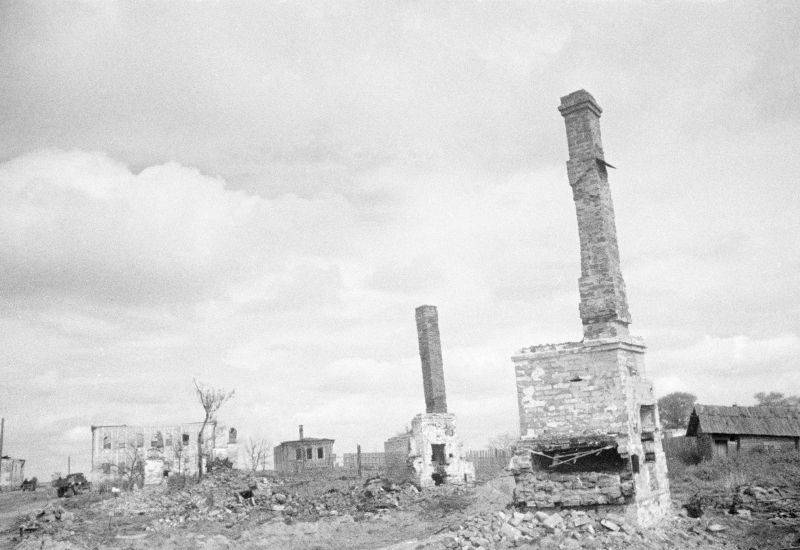
Destroyed houses on the street of liberated Dorogobuzh. September 1943
On August 28, 1943, the Polar Division attacked in the Elninsky direction. With the help of powerful artillery and aviation strikes, the Soviet infantry broke through the enemy’s defenses in an area up to 2 km wide and to a depth of 30–12 km in 15 days. On August 30, Burdeyny’s 2nd Guards Tank Corps was introduced into the breakthrough, which covered up to 20 km and, together with formations and units of the 10th Guards Army, captured a large road junction and a strong stronghold in the Smolensk direction - Yelnya. The Germans begin to withdraw troops in front of Polenov's 5th Army. On September 1, our troops liberated Dorogobuzh.
Soviet troops were advancing in a 150 km wide zone. The German command is transferring reinforcements from other sectors and occupying rear defensive lines. Soviet troops are again drawn into protracted positional battles. Progress is minimal - 1–3 km per day, losses are large. The number of fighters in the divisions was up to 3–4,5 thousand. The problem was the lack of ammunition. The Germans, having increased their forces in the Smolensk and Roslavl directions, stopped the advance of our forces.

Soviet mortar men marching along Lenin Street in liberated Dorogobuzh. At the time of the liberation of the city, only 64 buildings remained suitable for restoration. Many fundamental historical the buildings were blown up by retreating German troops.
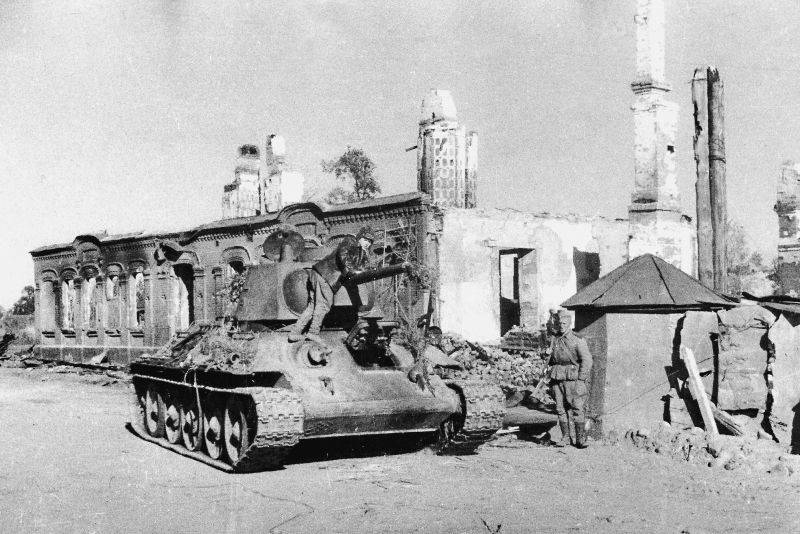
Soviet tank T-34 on the street of liberated Yelnya
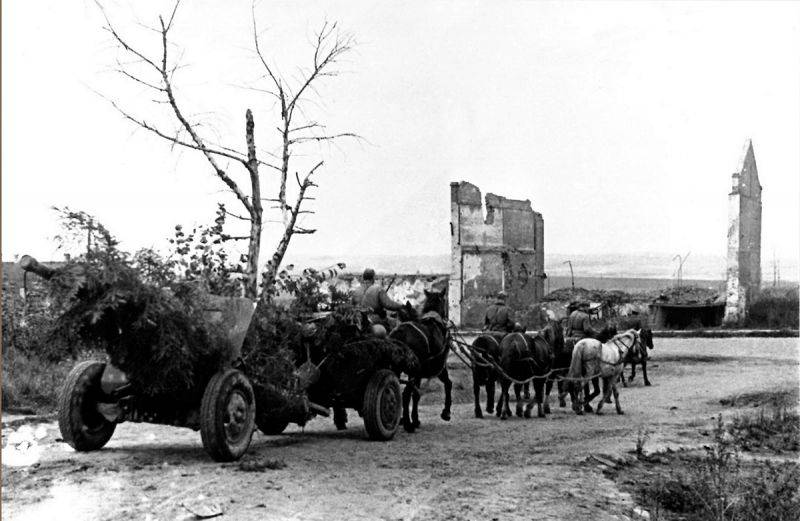
Red Army mounts transport a 76-mm divisional gun of the 1939 model (USV) along the street of liberated Yelnya
Liberation of Smolensk
The Soviet command was forced to take another pause. On September 7–14, 1943, Soviet troops consolidated their positions on occupied lines, conducted reconnaissance, and regrouped. The main task was the same - the liberation of Roslavl and Smolensk, the development of an offensive to the west.
The Polar Forces were preparing a strike in the direction of Smolensk and Orsha. The main blow was delivered by the 10th Guards Army, 21st and 33rd Armies, 2nd Guards Tank, 5th Mechanized, 6th and 3rd Guards Cavalry Corps. First, our troops had to break through enemy defenses in a 12 km wide area, occupy the Pochinka area, intercepting the railway and the Smolensk-Roslavl highway. Then, with part of your forces, liberate Smolensk, and with your main forces, conduct an offensive in the general direction of Orsha. The armies on the right wing (31st, 5th and 68th) were supposed to destroy the enemy in the Yartsev area and reach the Vop and Dnieper rivers. The armies on the left wing (49th and 10th) were supposed to cross the river. Desna and liberate the city of Roslavl.
The left wing of the CF was supposed to defeat the Nazis in the areas of Dukhovshchina and Demidov, then strike in the general direction of Rudnya and Vitebsk. The main role in the operation continued to be assigned to the 39th Army.
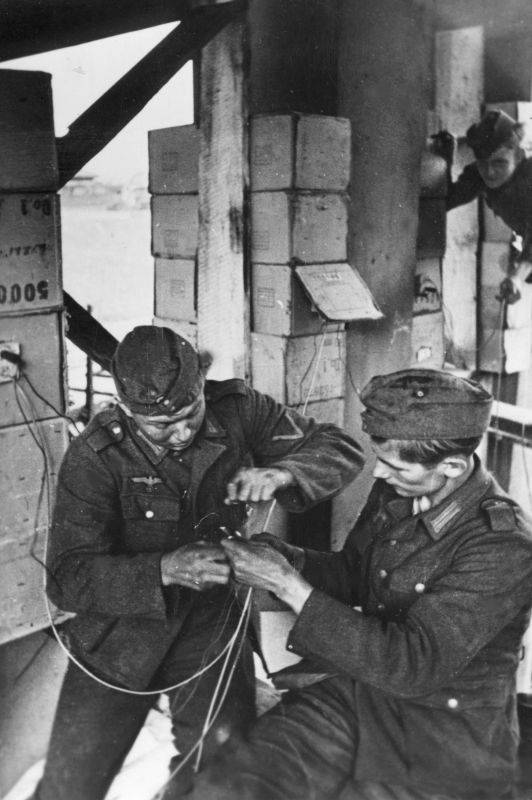
German sappers mine a bridge in Roslavl
On September 14, the offensive of the 39th Army and the left flank of the 43rd Army began. By the end of the day, they had advanced to a depth of 3 to 13 km, expanding the breakthrough to 30 km. Building on their success, the advanced units of the 39th Army, under the command of General Berzarin, liberated the city of Dukhovshchina on the night of September 19.
Headquarters assigned the CF troops the task of liberating Vitebsk. By September 30, the armies of the center and left wing of the Kalinin Front reached the Usvyaty-Rudnya line, but were unable to break the increased enemy resistance in the Vitebsk direction.
On September 15, the Polar Front troops went on the offensive for the third time. The next day, in the direction of the main attack, the breakthrough was expanded to 20 km wide and 10 km deep. The troops of the 31st Army captured a strong center of resistance - the city and railway station of Yartsevo, and the soldiers of the 10th Army crossed the river. Gum. By September 20, Soviet troops had fought 40 km. The headquarters decided that the enemy had been defeated and it was possible not only to liberate Smolensk, but also to capture the areas of Orsha and Mogilev by October 10–12.
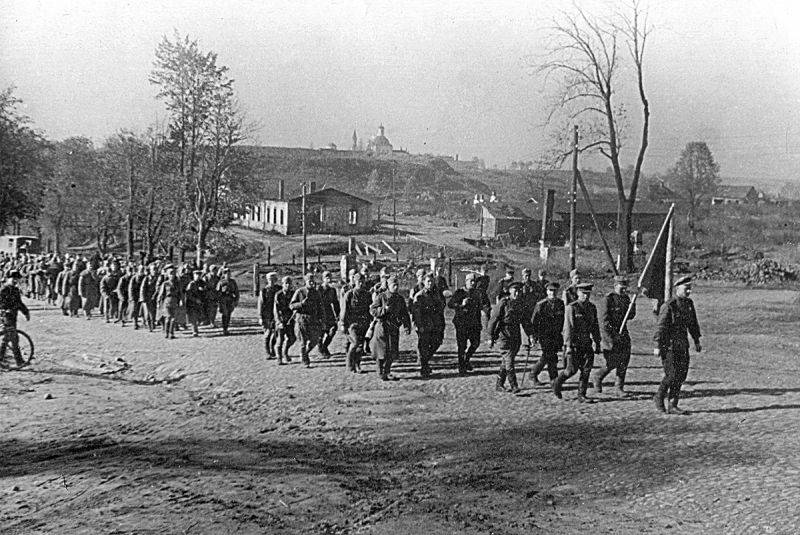
Soldiers of the 1099th Infantry Regiment (regiment commander Major Boris Ivanovich Elizarov) of the 326th Infantry Division enter liberated Roslavl. September 25, 1943
On the night of September 25, troops of the 31st, 5th and 68th armies of generals Gluzdovsky, Polenov and Zhuravlev made their way to Smolensk from various directions and soon completely cleared it of the Germans. Sappers began to establish crossings across the Dnieper and cleared the ruins of mines.
The commissar of the partisan detachment, Alexander Khomich, recalled:
Correspondent of the Krasnoarmeyskaya Pravda newspaper on the Western Front, Evgeny Vorobyov, wrote:
On the same day, units of the 10th Army, operating on the left wing, liberated Roslavl. On the evening of September 25, in honor of the double victory, Moscow saluted the troops of the Western Front with 20 artillery salvoes from 244 guns.
Continuing the offensive, Soviet troops crossed the river on the move. Sozh, the cities of Krasny, Mstislavl, and Krichev were liberated. On October 2, the Red Army reached the line Eliseevka, Lyady, Lenino, Dribin and further south along the river. Pronya to Petukhovka. However, their attempts to break through to Orsha and Mogilev were unsuccessful. Operation Suvorov was completed.
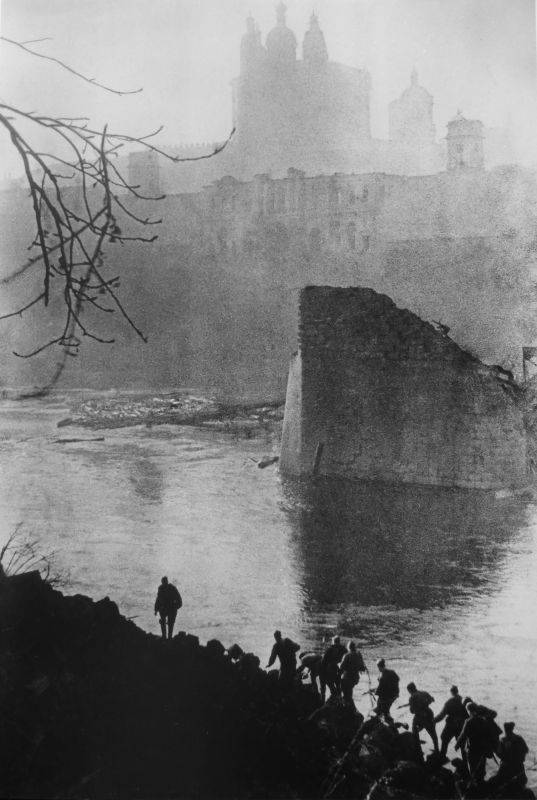
Scouts of the 169th separate reconnaissance company (commander - captain Vasily Vasilyevich Ushakov) of the 133rd rifle division on the banks of the Dnieper in liberated Smolensk. Cathedral Hill and the Assumption Cathedral are visible in the background. Scouts are looking for a place to target the crossing of the Dnieper.
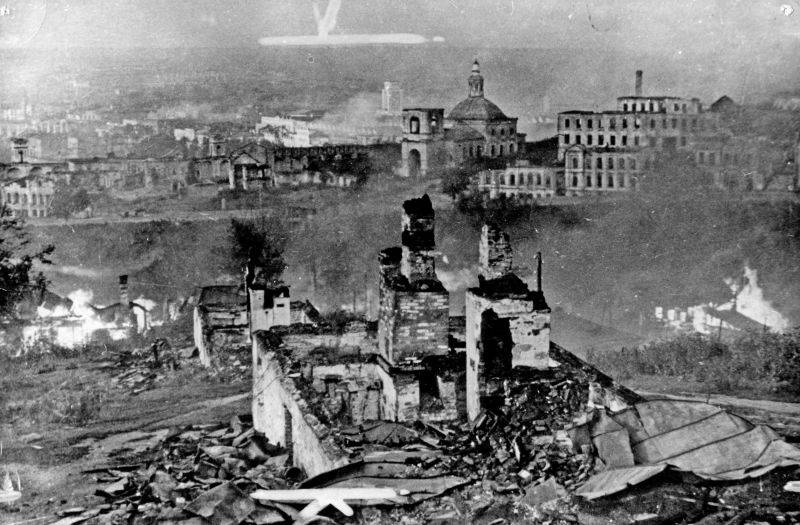
Panorama of destroyed Smolensk after the retreat of German troops
Results
The troops of the left wing of the Kalinin and Western fronts, having launched an offensive in a zone up to 400 km wide, advanced to a depth of 200–250 km. They liberated the territory of the Smolensk region, over 7 settlements, including the cities of Smolensk, Roslavl, Yartsevo, Yelnya, Spas-Demensk, Dorogobuzh, Dukhovshchina and Demidov. The liberation of Belarus began.
7 Wehrmacht divisions were defeated, another 14 divisions suffered heavy losses in manpower and equipment.
To stop the Russian offensive, the German command was forced to transfer 16 different formations to the Smolensk and Roslavl directions. The Kalinin and Western fronts tied down about 55 German divisions, which contributed to the successful development of the offensive in the southern strategic direction.
The Red Army failed to destroy the Smolensk group of Army Group Center. The Germans successfully defended themselves and transferred reinforcements, which Soviet aviation could not prevent. As necessary, German formations retreated to the rear, pre-prepared defensive lines. The Soviet army and corps failed to break through the enemy’s defenses to great depth, creating pockets and destroying the encircled German formations.
After operational pauses, the Red Army had to ram enemy defenses three times. Change the direction of the main attack, regrouping forces and means. When there is a shortage of ammunition and fuel. The losses were high - over 450 thousand people (more than 100 thousand irrevocable), more than 850 tanks and self-propelled guns.
Total German losses, according to Soviet data: 200–250 thousand people, according to German ones - 70 thousand.
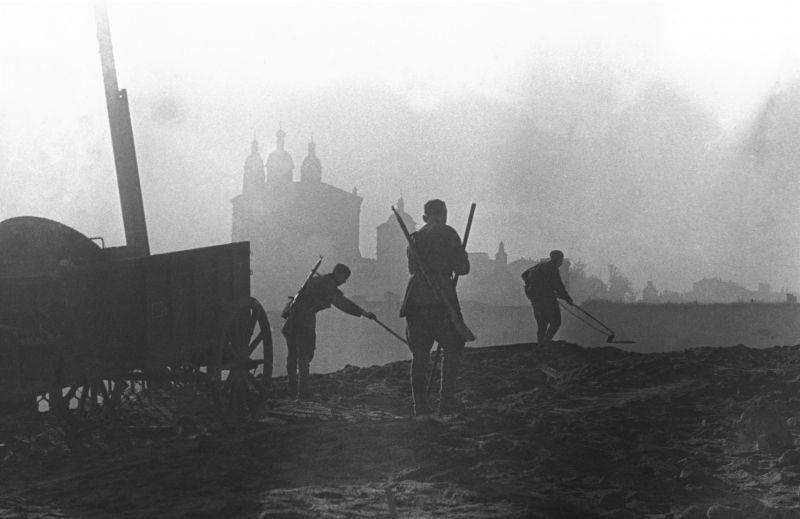
Soviet sappers are clearing mines along the Dnieper embankment in liberated Smolensk. Cathedral Hill and the Assumption Cathedral are visible in the distance
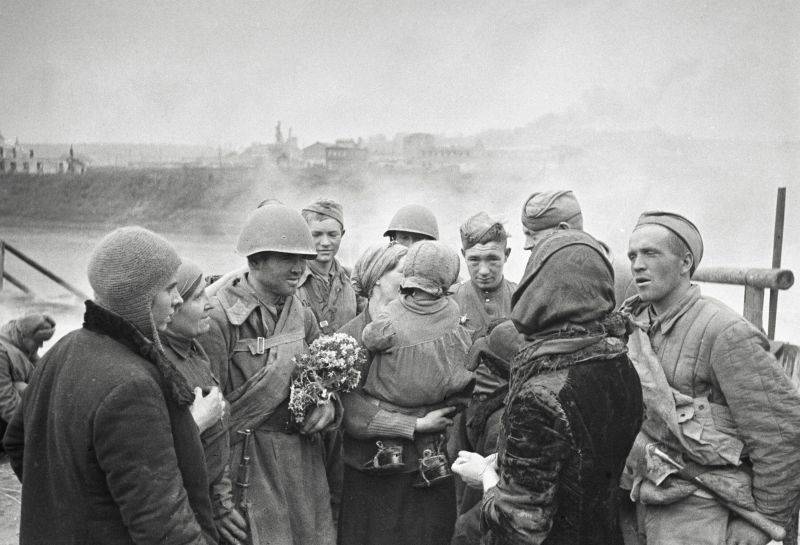
Residents of Smolensk talk with the soldiers who liberated Smolensk
Information